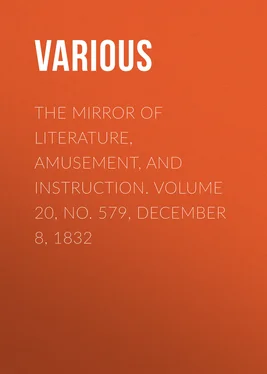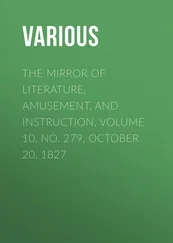Various - The Mirror of Literature, Amusement, and Instruction. Volume 20, No. 579, December 8, 1832
Здесь есть возможность читать онлайн «Various - The Mirror of Literature, Amusement, and Instruction. Volume 20, No. 579, December 8, 1832» — ознакомительный отрывок электронной книги совершенно бесплатно, а после прочтения отрывка купить полную версию. В некоторых случаях можно слушать аудио, скачать через торрент в формате fb2 и присутствует краткое содержание. Жанр: foreign_antique, periodic, Развлечения, foreign_edu, на английском языке. Описание произведения, (предисловие) а так же отзывы посетителей доступны на портале библиотеки ЛибКат.
- Название:The Mirror of Literature, Amusement, and Instruction. Volume 20, No. 579, December 8, 1832
- Автор:
- Жанр:
- Год:неизвестен
- ISBN:нет данных
- Рейтинг книги:5 / 5. Голосов: 1
-
Избранное:Добавить в избранное
- Отзывы:
-
Ваша оценка:
- 100
- 1
- 2
- 3
- 4
- 5
The Mirror of Literature, Amusement, and Instruction. Volume 20, No. 579, December 8, 1832: краткое содержание, описание и аннотация
Предлагаем к чтению аннотацию, описание, краткое содержание или предисловие (зависит от того, что написал сам автор книги «The Mirror of Literature, Amusement, and Instruction. Volume 20, No. 579, December 8, 1832»). Если вы не нашли необходимую информацию о книге — напишите в комментариях, мы постараемся отыскать её.
The Mirror of Literature, Amusement, and Instruction. Volume 20, No. 579, December 8, 1832 — читать онлайн ознакомительный отрывок
Ниже представлен текст книги, разбитый по страницам. Система сохранения места последней прочитанной страницы, позволяет с удобством читать онлайн бесплатно книгу «The Mirror of Literature, Amusement, and Instruction. Volume 20, No. 579, December 8, 1832», без необходимости каждый раз заново искать на чём Вы остановились. Поставьте закладку, и сможете в любой момент перейти на страницу, на которой закончили чтение.
Интервал:
Закладка:
Various
The Mirror of Literature, Amusement, and Instruction / Volume 20, No. 579, December 8, 1832
ANTWERP
This Engraving may prove a welcome pictorial accompaniment to a score of plans of "the seat of war," in illustration of the leading topic of the day. The view may be relied on for accuracy; it being a transfer of the engraving in "Select Views of the Principal Cities of Europe, from Original Paintings, by Lieutenant Colonel Batty, F.R.S. 1 1 Copied by permission of the proprietors and publishers, Messrs. Moon, Boys, and Graves.
" We have so recently described the city, that our present notice must be confined to a brief outline.
Antwerp, one of the chief cities of the Netherlands, is situated on the river Scheldt, 22 miles north of Brussels, and 65 south of Amsterdam: longitude 4° 23' East; latitude 51° 13' North. It is called by Latin writers, Antverpia , or Andoverpum ; by the Germans, Antorf ; by the Spanish, Anveres ; and by the French, Anvers . 2 2 The name of Antwerp, says an ingenious correspondent, at p. 287, vol. xiv. of The Mirror , is derived from Hand-werpen , or Hand-thrown : so called from a legend, which informs us that on the site of the present city once stood the castle of a giant, who was accustomed to amuse himself by cutting off and casting into the river the right hands of the unfortunate wights that fell into his power; but that being at last conquered himself, his own immense hand was disposed off, with poetical justice, in the same way. We quote this passage in a note, as it is only worthy of place beneath facts of sober history.
The city is of great antiquity, and is supposed by some to have existed before the time of Cæsar. It was much enlarged by John, the first Duke of Brabant, in 1201; by John, the third, in 1314; and by the Emperor Charles V. in 1543: it has always been a place of commercial importance, and about twenty years after the last mentioned date, the trade is concluded to have been at its greatest height; the number of inhabitants was then computed at 200,000. A few years subsequently, Antwerp suffered much in the infamous war against religious freedom, projected by the detestable Philip II. (son of Charles V.) and executed by the sanguinary Duke of Alva, whose cruelty has scarcely a parallel in history. In this merciless crusade, Alva boasted that he had consigned 18,000 persons to the executioner; and with vanity as disgusting as his cruelty, he placed a statue of himself in Antwerp, in which he was figured trampling on the necks of two statues, representing the two estates of the Low Countries. Before the termination of the war, not less than 600 houses in the city were burnt, and 6 or 7,000 of the inhabitants killed or drowned. Antwerp was retaken and repaired by the Prince of Parma, in 1585. It has since that time been captured and re-captured so frequently as to render its decreasing prosperity a sad lesson, if such proof were wanting, of the baleful scourge of war. The reader need scarcely be reminded that the last and severest blow to the prosperity of Antwerp was occasioned by the overthrow of Buonaparte, when, by the treaty of peace signed in 1814, her naval establishment was utterly destroyed. 3 3 See Antwerp described from a Tour in South Holland in the Family Library , at p. 109. vol. xviii of The Mirror .
The population has dwindled to little more than one-fourth of the original number, its present number scarcely exceeding 60,000.
The annexed view is taken from the Téte de Flandre , a fortified port on the left bank of the river Scheldt, immediately opposite to the city, and now in the possession of the Dutch. The river here is a broad and noble stream, and at high water navigable for vessels of large tonnage. A short distance below the town the banks are elevated, like part of Millbank, near Vauxhall Bridge; and the situation has much the same character. The river is here about twice the width of the Thames at London Bridge, and it flows with great rapidity.
Lieut.-Colonel Batty observes, "there is perhaps no city in the north of Europe which, on inspection, awakens greater interest" than Antwerp. It abounds in fine old buildings, which bear testimony to its former wealth and importance. The three most aspiring points in the View are—1. the Church of St. Paul, richly dight with pictures by Teniers, De Crayer, Quellyn, De Vos, Jordaens, &c.; 2. the tower of the Hôtel de Ville, the whole façade of which is little short of 300 feet, a part of the front being cased with variegated marble, and ornamented with statues; 3. the lofty and richly-embellished Tower of the Cathedral of Nôtre Dame, forming the most striking object from whichever side we view the city. The interior is enriched with valuable paintings by Flemish masters; the height of the spire is stated at 460 feet. 4 4 See Antwerp Cathedral, Mirror , vol. xiv, p. 286.
The distance from the mouth of the Scheldt to Antwerp is usually reckoned to be sixty-two miles, allowing for the bending of the river. At Lillo, an important fortress, the appearance of the city of Antwerp becomes an interesting object, and the more imposing the nearer the traveller approaches along the last reach of the Scheldt.
Antwerp has been the birthplace of many learned men—as, Ortelius, an eminent mathematician and antiquary of the sixteenth century, and the friend of our Camden; Gorleus, a celebrated medallist, of the same period; Andrew Schott, a learned Jesuit, and the friend of Scaliger; Lewis Nonnius, a distinguished physician and erudite scholar, born early in the seventeenth century. Few places have produced so many painters of merit, as will be seen at page 380, by a well-timed communication from our early correspondent P.T.W.
A MALTESE LEGEND
Hark, in the bower of yonder tower,
What maiden so sweetly sings,
As the eagle flies through the sunny skies
He stayeth his golden wings;
And swiftly descends, and his proud neck bends,
And his eyes they stream with glare,
And gaze with delight, on her looks so bright,
As he motionless treads the air.
But his powerful wings, as she sweetly sings,
They droop to the briny wave,
And slowly he falls near the castle walls,
And sinks to his ocean grave.
Was it arrow unseen with glancing sheen,
The twang of the string unheard,
Sped from hunter's bow, that has laid him low,
And has pierced that kingly bird?
That has brought his flight, from the realms of light,
Where his hues in ether glow,
To float for awhile in the sun's last smile,
Then dim to the depths below?
No! the pow'rful spell, that had wrought too well,
Was sung by a maiden true,
And it breath'd and flow'd, to her love who row'd,
His path through the seas of blue.
As she saw his sail, by the gentle gale,
Slow borne to her lofty bower,
Her heart it beat, in her high retreat,
She sang by a spell-bound power:
"Zephyr winds, with gentlest motion
Urge his bark the blue waves o'er;
Cease your wild and deep commotion
Waft him safely to the shore.
"Lovely art thou crested billow,
On thy whiteness rests his eye,
Thou art to his bark a pillow,
Thou dost hear his ev'ry sigh.
"Would I were yon dolphin dancing
Round his fragile vessel's stern;
Ev'ry gaze my soul entrancing,
I would woo him though he spurn."
Here she rais'd her eyes, to the once bright skies,
For she heard the deep sea groan,
And her song it stopp'd, and her hands they drop'd,
Her face grew white as the foam;
For the lovely blue, was hid from her view,
By a black and mighty cloud!
She saw in each wave, a watery grave,
And again she sang aloud:
Интервал:
Закладка:
Похожие книги на «The Mirror of Literature, Amusement, and Instruction. Volume 20, No. 579, December 8, 1832»
Представляем Вашему вниманию похожие книги на «The Mirror of Literature, Amusement, and Instruction. Volume 20, No. 579, December 8, 1832» списком для выбора. Мы отобрали схожую по названию и смыслу литературу в надежде предоставить читателям больше вариантов отыскать новые, интересные, ещё непрочитанные произведения.
Обсуждение, отзывы о книге «The Mirror of Literature, Amusement, and Instruction. Volume 20, No. 579, December 8, 1832» и просто собственные мнения читателей. Оставьте ваши комментарии, напишите, что Вы думаете о произведении, его смысле или главных героях. Укажите что конкретно понравилось, а что нет, и почему Вы так считаете.











